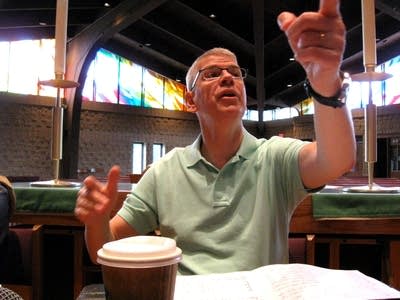Like Lou Gehrig, Bruce Kramer turns to Mayo

Editor's note: This is part of our continuing series of stories about Bruce Kramer, the former dean of the College of Education, Leadership and Counseling at the University of St. Thomas, as he copes with life after being diagnosed with ALS, also known as Lou Gehrig's Disease. You can read all the stories in the series by clicking here.
Bruce Kramer was just a few minutes into what would eventually be a four-hour assessment of his ongoing battle with ALS - Lou Gehrig's Disease - when his Mayo Clinic physician popped him a question that he'd secretly dreaded.
"How's your memory been?" Dr. Lyell Jones asked.
"Actually, you just hit on probably the most deeply seeded fear I have," Kramer said. "Which is, 'Is there going to be some cognitive disruption here?"
Create a More Connected Minnesota
MPR News is your trusted resource for the news you need. With your support, MPR News brings accessible, courageous journalism and authentic conversation to everyone - free of paywalls and barriers. Your gift makes a difference.
"I don't see it so far," Kramer said in answer to his own question.
"He remembers for all of us. We all forget," Kramer's wife added, prompting a laugh from the couples' two children who are also part of the Mayo interview.
Jones, a Mayo neurologist, is part of a team that sees about 120 people, including Kramer's amyotrophic lateral sclerosis.
"It's a mouthful," he said. "We know it as ALS. Most people call it Lou Gehrig's Disease."
In fact, Gehrig, the 1930s Hall of Fame baseball star, was diagnosed and treated for ALS at Mayo. The famed "Iron Horse" showed up in Rochester in 1939 with puzzling symptoms: His hands ached, his legs felt weak, and his muscles were slowly deteriorating. His condition had harmed his playing ability for the New York Yankees in the 1938 season so badly that he'd benched himself. (ESPN has a collection of letters Gehrig wrote to Mayo here.)
After his 1939 diagnosis, he retired, and the Yankees held "Lou Gehrig Appreciation Day" that year on the Fourth of July.
"Fans, for the past two weeks you have been reading about the bad break I got," he said that day. "Yet today I consider myself the luckiest man on the face of this Earth. I have been in ballparks for 17 years and have never received anything but kindness and encouragement from you fans."
Gehrig died two years later. He was 37.
"There's a progression of the disease over time because of the degeneration of neurons," Mayo's Jones explained. "ALS, in most patients, affects a specific group of neurons called motor neurons. There are some in the brain and some in the spinal cord. We know the muscles waste away because of the loss of the nerves. We know that. But what we don't know terribly well or understand terribly well is what sets this process off for most people."
Still, experts are optimistic about beating the disease thought to affect as many as 30,000 Americans.
"We have a lot of hope that understanding the pathophysiology of this disease will lead us to better treatments," Jones said.
As researchers learn more about how ALS affects the body, they continue to try out an arsenal of drugs. So far, only one has demonstrated even a little bit of effectiveness in improving the survival rate of patients.
"It isn't for lack of trying," Jones said.
Kramer is part of an experimental drug trial - he doesn't know if he's getting the drug, or a placebo.
"I still see the [ALS] progression, but I feel better. My head feels better. I feel clearer," Kramer said, even though his body feels weaker. "I ask myself, am I getting better? Am I on the drug or it is the placebo effect? Well...viva la placebo!"
During his Mayo visit, he asked Jones whether it's possible some environmental trigger such as water pollution may have played a role in his contracting ALS.
"There's no clear environmental triggers that have been identified," Jones told him. "It would be nice if we could because we could then just identify those triggers and try and control them. Unfortunately, while we, in some studies, see some risk factors, other studies might not confirm those."
Looking to the future, Jones said, "My suspicion is almost certainly that there will be some sort of environmental precipitant or trigger combined with some sort of genetic predisposition of requirement for it. It almost certainly is going to be complex."
"It feels like, very simplistically, a perfect storm," Kramer replied. "All these little factors and something tipped it and there you are!"
In the meantime, treating ALS is a matter of helping patients navigate its progression.
"What I tell my patients is that while this disease, like many diseases we see is a condition that we can't reverse, I have yet to meet a patient that we can't treat," Jones said. The challenge is treating the symptoms while helping patients stay optimistic.
"What is the difference between hope and optimism?" Kramer asked aloud. "Is there a difference? And I realized that, yeah, there is a huge difference. Optimism is a state of being. So I'm not optimistic. But I'm hopeful."
Here's part of Lou Gehrig's speech:
---
You can read all the stories in this series by clicking here.


